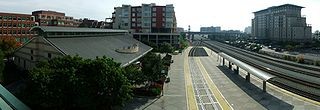So, what is smart growth?

“The central tenet of smart growth,” Greg Dierkers, Erin Silsbe, Shayna Stott, Steve Winkelman and Mac Wubben of the Center for Clean Air Policy in its “CCAP Transportation Emissions Guidebook – Part One: Land Use, Transit & Travel Demand Management” stress, “is the return to more compact built forms that are typically more walkable, more livable and less reliant on the automobile for daily transportation needs. Smart growth strategies place an emphasis on urban sustainability and include among others:
- concentrated activity centers
- mixed use development
- increased density near transit
- pedestrian oriented design
- interconnected travel networks
- parking management
- open space preservation
“The creation of more walkable urban environments requires both a larger scale, regional approach that promotes higher densities, mixed uses and transit-oriented communities, as well as site-level urban design features that promote safety and access to local services on foot.”
Please take note of the reference “the return to more compact built forms,” the operative word here being “return.”
So, it is sort of ironic that what was once the standard practice in planning and building approaches, compactness being a principal part of the design and those designs encouraging pedestrian activity, incidentally, with reasonable-to-good access to transit, is what made them work originally but also what makes them work – and appealing – now.
In essence, what smart growth is today is a return to past planning and development trends.
So, why is this type of growth strategy important now?
There are many reasons or considerations. Among these are: land-use efficiency considerations, mobility considerations, environmental considerations, agricultural and open space preservation considerations, and housing considerations and the consideration of promoting improved health or healthier living.
What’s more, probably the most important smart-growth asset is having options or choice. Another is convenience.
Now contrast smart-growth orientation with the orientation that defines suburbia.
The chief characteristic of suburbia is single-family, detached, automobile-centric housing. Expansion of such is outward rather than upward which, consequently, leads to sprawl and encourages driving.
And both types of development styles or strategies have their place, obviously.
But there is something I think should be conveyed one in relation to the other.
Jeff Turrentine in “Neighborhood Watch” as someone who’s experienced suburban living first-hand with strong suburban family ties still, argues that smart growth benefits all, regardless of whether city slicker, country bumpkin, local yokel, suburbanite or what-have-you.
“… I believe the champions of sustainability should be emphasizing how ideas that fall under the rubric of smart growth benefit all of us, wherever we reside. Their new message needs to be: if you really love your suburban quality of life, then know that the greatest threat to it isn’t coming from bureaucrats, environmentalists, or liberal politicians. It’s coming from that brand new, almost-completed housing development going up right next to yours,” Turrentine opined.
Added the OnEarth articles editor: “In the century since they first appeared on our physical and cultural horizon, the suburbs have earned the right to consider themselves every bit as American as our gleaming cities and rolling farmlands. There’s no stealth plan to ‘abolish’ them. There is, instead, a perfectly transparent plan to include them in the list of communities that must be brought into the sustainability fold if we’re ever to address climate change effectively, protect wildlife habitat, and ensure that we don’t pollute or deplete our resources to the point of no return. Smart growth is great for cities — but it’s great for suburbs too. People who love them should understand that any concerted effort to make them cleaner, prettier, safer, and less congested is a conspiracy worth joining.”
Smart growth: it isn’t just location-efficient, eco-, transit- and pedestrian-friendly, compactly built and mixed-use-centric, it’s, well, smart!
– Alan Kandel